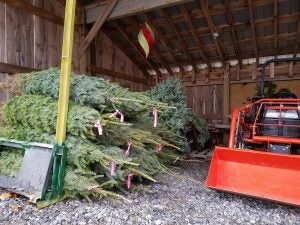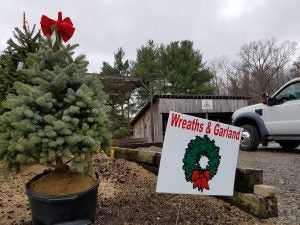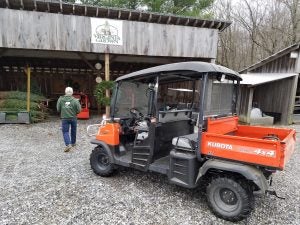“Whether you’re harvesting one or 1,000 trees, it’s just one at a time with a chainsaw.”
For all of the automation that the agriculture industry has at its disposal, Robert O’Keeffe says for our seasonal stalwart, the Christmas tree, there’s no way to avoid a slow and labor-intensive process. The rows are small, and there’s no guarantee that you’d harvest every tree in a row because trees don’t grow at a uniform pace.
So around the holidays, it’s mark the best trees, cut one down, drag it by hand out of the row, place it on a trailer, and repeat.

O’Keeffe, 68, owns Rifton Farm & Nursery, a 20,000-tree business he’s had in Pilot, Virginia, for more than 40 years. He didn’t have a farming background when he bought the place, and there were a few misconceptions of tree-growing that he had to overcome when he got started. But his smarts, adaptability, and work ethic paid off.
“Since 1975, I’ve gone to the college of hard knocks, and those lessons have been expensive,” O’Keeffe says. “But those are the ones that stick with you.
“I thought you could just plant the trees, and then six or seven years later, you come back in and cut them.”
The reality is that you have to shape them regularly, take soil samples, fertilize, spray the rows in spring and sometimes late summer with herbicide, check for pests, check for disease, and mow between the rows.
“It’s year-round maintenance,” he says.
It can take as many as 10 years to grow a tree to 6 feet, which is the average retail sale height. However, the average growing time is about seven years. (The popular Fraser firs, which require at least 2,500 feet of elevation, are widely known to be slow-growers.)

There’s no question that the U.S. does a good job “keeping it real” — real Christmas trees are grown on a total of 15,000 farms across all 50 states, with Oregon, Michigan, Wisconsin, Pennsylvania, and California as the top five producers. Virginia, which is where O’Keeffe’s farm is, has about 600 Christmas tree farms and is seventh nationally in total trees harvested.
A good product makes for a good industry. O’Keeffe will prune the bottom of a tree, which makes it easier to get into a tree stand, before the customer takes it, and most trees leave his farm baled so that they are easier for buyers to handle.
“I just want customers to be happy,” he says.
Variety has helped his business survive drought, deer, and hardships that Mother Nature has thrown at him. He began his farm by offering white pines, but once they fell out of favor, he adapted to Fraser firs, Norway spruce, Colorado blue spruce, and Serbian spruce. For the Serbians, the underside of the needle is blue, and the top is green. “They tell me that when they put lights on them at night, the blue just shimmers,” O’Keeffe says.
Still, “it’s funny how things go in cycles,” he says. “The past couple of years, I’ve been getting calls for white pines again.”
O’Keeffe sells to retail outlets as well as offering choose-and-cut for families who want to visit the farm. He prefers the choose and cut side because he gets to meet the families and the kids. He has many regular customers, some even third-generation coming back to pick out trees.

Things in the tree business really get rolling the weekend after Thanksgiving, though he’s seeing more and more families buying before Thanksgiving — he says that’s because they’ll celebrate that holiday with one side of the family and visit with the other side of the family on Christmas. Multiple holiday celebrations are getting rolling into the family gatherings.
Foot traffic on his farm has been growing. Even moreso after O’Keeffe’s stock went up last year, when he was selected grand champion of the Virginia Christmas Tree Growers Association; one of his 13-foot Canaan fir was chosen to be put in the governor’s mansion. It’s helped his marketing and how retailers are able to connect with him.
“I’ve found that printed material anymore is kind of a waste of time. Everyone is on the internet,” O’Keeffe says.
With more than 37 million American families celebrating the holidays with a real Christmas tree, growers nationwide have their work cut out for them. Getting the word out is just one piece of the puzzle — like every farmer, there are obstacles along the way. The difficulties for a tree farmer might be different from those of other crops, but everyone can understand the damage that a fungus or a deer or a bear can do to a tree. O’Keeffe even jokes that deer have good taste and too often target the high-dollar trees.
“In agriculture, there’s nothing easy, and there’s no way you’re going to get rich. But I enjoy it,” O’Keeffe says.



